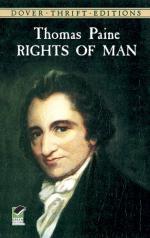
|
| Name: _________________________ | Period: ___________________ |
This test consists of 15 multiple choice questions and 5 short answer questions.
Multiple Choice Questions
1. As he noted in the Preface, where did Paine desire to collect his political thoughts?
(a) In one place.
(b) In several places.
(c) In two places.
(d) In many places.
2. Referencing the Declaration of the Rights of Man and Of Citizens, by the National Assembly of France, what did Paine state was the purpose of government?
(a) To decide which rights are natural and inalienable.
(b) To ensure that no citizen earns more than a decided amount.
(c) To provide funds for those that are lacking.
(d) To protect and promote natural, inalienable human rights.
3. Why did Paine have an accurate account of the Revolution he discussed in Rights of Man?
(a) He was on the ground during the war.
(b) He researched the war from several different sources.
(c) He got reports from generals in the war.
(d) He had seen previous wars.
4. What happened to responsibility when a country attempted to blend both influences that Paine referenced in the Conclusion of Part One?
(a) It would be altered.
(b) It would be replaced.
(c) It would be misplaced.
(d) It would be lost.
5. As explained by Paine in the Conclusion of Part One, which two forces was mankind influenced by?
(a) Curiosity and ignorance.
(b) Reason and ignorance.
(c) Curiosity and knowledge.
(d) Reason and knowledge.
6. In the beginning of Rights of Man, how did Paine describe Burke's pamphlet?
(a) Exaggerations, bigotry, and hatred.
(b) Lies, bigotry, and exaggerations.
(c) Lies, exaggerations, and hatred.
(d) Lies, bigotry, and hatred.
7. Based on the Declaration of the Rights of Man and Of Citizens, by the National Assembly of France, whose will did the law express?
(a) Other governments.
(b) The previous officials.
(c) The government.
(d) The community.
8. What analogy did Paine draw between the American Revolution and the French Revolution in Rights of Man?
(a) They both lasted for the same amount of time.
(b) They happened in the same place.
(c) They happened at the same time.
(d) They were both fought for similar reasons.
9. Ending the Miscellaneous Chapter, what did Paine think was missing from Burke's objection to the French Revolution?
(a) Validity.
(b) Honor.
(c) Support.
(d) Intent.
10. After pointing out the weaknesses of Burke's position, what did Paine indicate about Burke's principle of past English laws?
(a) It contradicted itself.
(b) It defeated itself.
(c) It diminished itself.
(d) It outsmarted itself.
11. What did Paine do to help the cause being fought for in the American Revolution?
(a) He made a political case for it and planned its strategy.
(b) He made a political case for it and supported the troops.
(c) He supported the troops and planned the war's strategy.
(d) He made an ethical case for it, planned its strategy, and supported the troops.
12. In order to clarify an important aspect of the French Revolution, what did Paine say was the intention of the French people?
(a) To rebel against neither the principles that empowered tyrants nor the men themselves.
(b) To rebel against the men themselves, not the principles that empowered tyrants.
(c) To rebel against both the principles that empowered tyrants and men themselves.
(d) To rebel against principles that empowered tyrants, not men themselves.
13. Which other war had Burke previously supported?
(a) French and Indian War.
(b) Seven Years War.
(c) American Revolution.
(d) Glorious Revolution.
14. What mood was the beginning of the second Preface of Rights of Man written by Paine?
(a) Angry.
(b) Exhausted.
(c) Defensive.
(d) Excited.
15. What is a good description of the second part of Rights of Man?
(a) Fictional.
(b) Philosophical.
(c) Biographical.
(d) Autobiographical.
Short Answer Questions
1. Because of the American and French Revolutions, what was being undermined about the old governments in Paine's opinion?
2. What crucial point did Paine make about power in the Miscellaneous Chapter?
3. Why did Paine choose to write a Miscellaneous Chapter of miscellaneous thoughts?
4. How did Paine describe the mismanagement of government finances in countries like England and France?
5. How did Paine depict his feelings in the Preface about the way readers of his work were being punished in some countries?
|
This section contains 691 words (approx. 3 pages at 300 words per page) |

|




